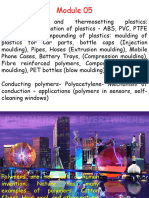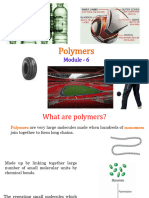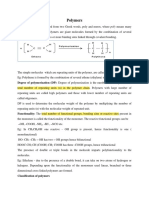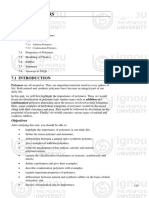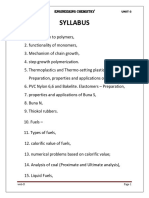Unit-2a: Polymers: Lecture 2
Uploaded by
Utkarsh SinghUnit-2a: Polymers: Lecture 2
Uploaded by
Utkarsh SinghPolymers: Lecture 2
Unit-2a
Classification of Polymers
1. Based on Structure/Shape of polymer
Polymers can be linear, branched, cross linked or networked.
secondary
bonding
Linear Branched Cross-Linked Network
• Linear polymers have monomeric units joined end to end in single chains. There may
be extensive van der Waals and hydrogen bonding between the chains. Examples:
polyethylene, PVC, nylon.
• In branched polymers, side-branch chains are connected to main chains. HDPE – high
density polyethylene is primarily a linear polymer with minor branching, while LDPE
– low density polyethylene contains numerous short chain branches. Greater chain
linearity and chain length tend to increase the melting point and improve the physical
and mechanical properties of the polymer due to greater crystallinity.
• In cross-linked polymers, adjacent linear chains are joined to one another at various
positions by covalent bonding of atoms. Examples are the rubber elastic materials.
• Small molecules that form 3 or more active covalent bonds create structures called
network polymers. Examples are the epoxies and polyurethanes.
2. Based on number of monomers:
Polymers can be homopolymers when only one type of monomer is present (eg:
polyethylene, polypropylene, polyvinyl chloride).
Polymers can be co-polymer when two or more types of monomeric units are present
(eg: styrene, acrylonitrile etc)
Homopolymers – only one monomer (repeating unit): - A – A – A – A – A – A – A -
Copolymer – more than one monomer
Statistical Copolymers Also called random copolymers. Here the monomeric units are
distributed randomly, and sometimes unevenly, in the polymer
chain: ~ABBAAABAABBBABAABA~.
Alternating Copolymers Here the monomeric units are distributed in a regular alternating
fashion, with nearly equimolar amounts of each in the
chain: ~ABABABABABABABAB~.
Block Copolymers Instead of a mixed distribution of monomeric units, a long sequence
or block of one monomer is joined to a block of the second
monomer: ~AAAAA-BBBBBBB~AAAAAAA~BBB~.
Prepared by Dr Arunima Nayak and Dr Brij Bhushan
Polymers: Lecture 2
Unit-2a
Graft Copolymers As the name suggests, side chains of a given monomer are attached to
the main chain of the second
monomer: ~AAAAAAA(BBBBBBB~)AAAAAAA(BBBB~)AAA~.
Red Dot: A; Black Dot: B
3. Based on Origin:
Synthetic organic polymers
Biopolymers (proteins, polypeptides, polynucleotide, polysaccharides, natural rubber)
Semi-synthetic polymers (chemically modified synthetic polymers)
Inorganic polymers (siloxanes, silanes, phosphazenes)
4. Based on Tacticity:
Polymers with regular substituents on the polymer chain possess a property known
as tacticity. Tacticity results from the different ways in which the substituents can be
arranged on the polymer backbone.
When the substituents are arranged in an irregular, random fashion, the polymer
is atactic (literally, no arrangement).
When the substituents are all on the same side of the chain, the polymer is
isotactic (literally, the same arrangement).
If the substituents alternate regularly from one side of the chain to the other, the polymer
is syndiotactic.
Atactic
polypropylen
e
Prepared by Dr Arunima Nayak and Dr Brij Bhushan
Polymers: Lecture 2
Unit-2a
Syndiotactic
polystyrene
Isotactic
poly(vinyl
chloride)
5. Based on Intermolecular fources
Elastomers: These are rubber like solids with elastic properties. the polymer chains are
held together by the weakest intermolecular forces. E.g. Buna-S, Buna-N, Neoprene,
etc.
Fibres: Fibres are the thread forming solids which possess high tensile strength and
high modulus. These characteristics can be attributed to the strong intermolecular forces
like hydrogen bonding. E.g. Polyamides (nylon 6,6), Polyesters(terylene), etc.
Thermoplastic polymers: These polymers possess intermolecular forces of attraction
intermediate between elastomers and fibres. E.g. Polythene, Polystyrene, Polyvinyl,
etc.
Thermosetting polymers: These polymers are cross-linked or heavily branched
molecules, which on heating undergo extensive cross-linking in molds and again
become infusible. These cannot be reused. E.g. Urea- Formaldehyde resins, Bakelite,
etc.
Prepared by Dr Arunima Nayak and Dr Brij Bhushan
Polymers: Lecture 2
Unit-2a
Addition and Condensation Polymerization:
Addition Polymerization: Addition polymers are formed when an unsaturated organic
compound (presence of double/triple bond) react to form long chain polymer molecule and
when no small molecules are eliminated during the reaction.
Some Common Addition Polymers
Name(s) Formula Monomer Properties Uses
Polyethylene ethylene film wrap, plastic
–(CH2-CH2)n– soft, waxy solid
low density (LDPE) CH2=CH2 bags
electrical
Polyethylene ethylene rigid, translucent
–(CH2-CH2)n– insulation
high density (HDPE) CH2=CH2 solid
bottles, toys
Poly(vinyl chloride) vinyl chloride pipes, siding,
–(CH2-CHCl)n– strong rigid solid
(PVC) CH2=CHCl flooring
hard, rigid, clear
toys, cabinets
Polystyrene –[CH2- styrene solid
packaging
(PS) CH(C6H5)]n– CH2=CHC6H5 soluble in organic
(foamed)
solvents
high-melting solid
Polyacrylonitrile acrylonitrile rugs, blankets
–(CH2-CHCN)n– soluble in organic
(PAN, Orlon, Acrilan) CH2=CHCN clothing
solvents
non-stick surfaces
Polytetrafluoroethylene tetrafluoroethylene resistant, smooth
–(CF2-CF2)n– electrical
(PTFE, Teflon) CF2=CF2 solid
insulation
Poly(methyl
lighting covers,
methacrylate) –[CH2- methyl methacrylate hard, transparent
signs
(PMMA, Lucite, C(CH3)CO2CH3]n– CH2=C(CH3)CO2CH3 solid
skylights
Plexiglas)
Poly(vinyl acetate) –(CH2- vinyl acetate latex paints,
soft, sticky solid
(PVAc) CHOCOCH3)n– CH2=CHOCOCH3 adhesives
Prepared by Dr Arunima Nayak and Dr Brij Bhushan
Polymers: Lecture 2
Unit-2a
Condensation Polymerization: The process of formation of polymer via condensation of two
different bi-or poly functional monomers having functional groups which have affinity to each
other. Condensation polymers form when:
Ø bifunctional monomers combine to form a long chain polymer molecule.
Ø small molecules like water is eliminated during the reaction.
Prepared by Dr Arunima Nayak and Dr Brij Bhushan
Polymers: Lecture 2
Unit-2a
Difference between addition and condensation polymerization
S.No Addition Polymerization Condensation Polymerization
1. Requires the presence of double Requires the presence of minimum two
bond in the monomer functional groups in a single monomer
which are of close proximity to each other
2. No by product is formed A byproduct like H2O, HCl etc is formed
3. Polymer formed is homopolymer Polymer formed is heteropolymer
4. Polymer is thermoplastic Polymer formed is thermosetting
5. Example: Example:
a. Ethylene polymerizing to a. Hexamethylene diamine and adipic
polyethylene acid polymerizing to nylon 66
b. Vinyl chloride polymerizing b. Caprolactum polymerizing to Nylon
to PVC 6
c. styrene polymerizing to c. Terepthallic acid and ethylene
polystyrene glycol polymerizing to polyethylene
terepthallate
Prepared by Dr Arunima Nayak and Dr Brij Bhushan
You might also like
- Organic_Chemistry_class_note_12_16869200061181591703648c5b46ed77bNo ratings yetOrganic_Chemistry_class_note_12_16869200061181591703648c5b46ed77b14 pages
- WINSEM2018-19 - CHY1701 - ETH - SJT304 - VL2018195004125 - Reference Material I - Module 7No ratings yetWINSEM2018-19 - CHY1701 - ETH - SJT304 - VL2018195004125 - Reference Material I - Module 739 pages
- Polymers and Organic Electronic MaterialsNo ratings yetPolymers and Organic Electronic Materials41 pages
- Polymer Poly Mers Parts or Units Many: DefinitionNo ratings yetPolymer Poly Mers Parts or Units Many: Definition80 pages
- Synthetic Polymer and Their ApplicationNo ratings yetSynthetic Polymer and Their Application22 pages
- MCG 2361 Engineering Materials II: Lecture 5: Molecular Structure and Materials Structure of Polymers (1/3)No ratings yetMCG 2361 Engineering Materials II: Lecture 5: Molecular Structure and Materials Structure of Polymers (1/3)60 pages
- Prof. Dr. F. Nawaz Khan, VIT UniversityNo ratings yetProf. Dr. F. Nawaz Khan, VIT University77 pages
- Polymers (ABS and BAKELITE) - Synthesis and Application - 08-04-2024No ratings yetPolymers (ABS and BAKELITE) - Synthesis and Application - 08-04-202445 pages
- Referance PPT for Introduction to polymersNo ratings yetReferance PPT for Introduction to polymers38 pages
- Polymers: Polymers Can Be Classified in Following WaysNo ratings yetPolymers: Polymers Can Be Classified in Following Ways9 pages
- Handbook of Oligo- and PolythiophenesFrom EverandHandbook of Oligo- and PolythiophenesDenis FichouNo ratings yet
- TOE 811-MC-L-3 MAC Issues in Mobile ComputingNo ratings yetTOE 811-MC-L-3 MAC Issues in Mobile Computing11 pages
- Polymers: Lecture 4 Unit-2b: Plastics and Fibers PlasticsNo ratings yetPolymers: Lecture 4 Unit-2b: Plastics and Fibers Plastics8 pages
- Polymers: Lecture 5 (Conducting Polymers) Unit-2aNo ratings yetPolymers: Lecture 5 (Conducting Polymers) Unit-2a3 pages
- Polymers: Lecture 3 Unit-2b: The Mechanism of Addition Polymerization100% (2)Polymers: Lecture 3 Unit-2b: The Mechanism of Addition Polymerization3 pages
- Polymers: Lecture 1 Unit-3a: Prepared by DR Arunima Nayak and DR Brij Bhushan0% (1)Polymers: Lecture 1 Unit-3a: Prepared by DR Arunima Nayak and DR Brij Bhushan2 pages
- 5.2 Design of T-Beams and Other Non-Rectangular BeamsNo ratings yet5.2 Design of T-Beams and Other Non-Rectangular Beams17 pages
- Analisis Volume Minyak Gaharu Tipe Aquilaria Malaccensis L. Pada Proses Penyulingan Minyak Gaharu Analysis of Volume Gaharu Oil TypeNo ratings yetAnalisis Volume Minyak Gaharu Tipe Aquilaria Malaccensis L. Pada Proses Penyulingan Minyak Gaharu Analysis of Volume Gaharu Oil Type7 pages
- Overview of Biomaterials and Their Use in Medical Devices: Uses For Biomaterials (Ref 3)No ratings yetOverview of Biomaterials and Their Use in Medical Devices: Uses For Biomaterials (Ref 3)6 pages
- Chapter ThermalCracksinConcreteStructure BasicIssuestobeUnderstood100% (2)Chapter ThermalCracksinConcreteStructure BasicIssuestobeUnderstood13 pages
- Mea Polybit Tds Polybit Polygrout Ey 3000 PH en MeaNo ratings yetMea Polybit Tds Polybit Polygrout Ey 3000 PH en Mea2 pages
- 2019 - Experimental Study of RC Deep Beam With Opening and FRP Composites Installed by Means of EBR and EBROGNo ratings yet2019 - Experimental Study of RC Deep Beam With Opening and FRP Composites Installed by Means of EBR and EBROG12 pages
- The Largest Coke Drum Bulge Repairs in Industry History Jani Reliance Industries Limited Samman Houston Engineering Solutions DCU New Delhi 2013No ratings yetThe Largest Coke Drum Bulge Repairs in Industry History Jani Reliance Industries Limited Samman Houston Engineering Solutions DCU New Delhi 201330 pages
- 130087-PO-M-B-501-VP-0351 - Rev.B (Refractory)No ratings yet130087-PO-M-B-501-VP-0351 - Rev.B (Refractory)22 pages
- Technical Datasheet - English - Parathane MatNo ratings yetTechnical Datasheet - English - Parathane Mat2 pages
- PP-R and PP-RCT Pipe Systems: Hot and Cold Water Systems and Heating ApplicationsNo ratings yetPP-R and PP-RCT Pipe Systems: Hot and Cold Water Systems and Heating Applications24 pages
- 36 Goes Here 37 Goes Here: Fuselage FormerNo ratings yet36 Goes Here 37 Goes Here: Fuselage Former6 pages
- Slab Thickness Design For Factory o R Wa PDFNo ratings yetSlab Thickness Design For Factory o R Wa PDF21 pages
- Role of Polyisocyanate in PU Coatings: How To Make A PU SystemNo ratings yetRole of Polyisocyanate in PU Coatings: How To Make A PU System5 pages
- Code Requirements For Determining Fire Resistance of Concrete and Masonry Construction Assemblies100% (1)Code Requirements For Determining Fire Resistance of Concrete and Masonry Construction Assemblies32 pages
- SCOPE+OF+ACCREDITATION (Construction+Materials+Testing) DCL TestingNo ratings yetSCOPE+OF+ACCREDITATION (Construction+Materials+Testing) DCL Testing34 pages
- Composites Communications: Mukesh Bajya, Abhijit Majumdar, Bhupendra Singh ButolaNo ratings yetComposites Communications: Mukesh Bajya, Abhijit Majumdar, Bhupendra Singh Butola5 pages
- Behaviour of Reinforced Concrete Frame Structures With Construction Joints Under Lateral Loads (1998) (10.1680 - Macr.1998.50.2.133) - LNo ratings yetBehaviour of Reinforced Concrete Frame Structures With Construction Joints Under Lateral Loads (1998) (10.1680 - Macr.1998.50.2.133) - L13 pages
- Organic_Chemistry_class_note_12_16869200061181591703648c5b46ed77bOrganic_Chemistry_class_note_12_16869200061181591703648c5b46ed77b
- WINSEM2018-19 - CHY1701 - ETH - SJT304 - VL2018195004125 - Reference Material I - Module 7WINSEM2018-19 - CHY1701 - ETH - SJT304 - VL2018195004125 - Reference Material I - Module 7
- MCG 2361 Engineering Materials II: Lecture 5: Molecular Structure and Materials Structure of Polymers (1/3)MCG 2361 Engineering Materials II: Lecture 5: Molecular Structure and Materials Structure of Polymers (1/3)
- Polymers (ABS and BAKELITE) - Synthesis and Application - 08-04-2024Polymers (ABS and BAKELITE) - Synthesis and Application - 08-04-2024
- Polymers: Polymers Can Be Classified in Following WaysPolymers: Polymers Can Be Classified in Following Ways
- Polymers: Lecture 4 Unit-2b: Plastics and Fibers PlasticsPolymers: Lecture 4 Unit-2b: Plastics and Fibers Plastics
- Polymers: Lecture 3 Unit-2b: The Mechanism of Addition PolymerizationPolymers: Lecture 3 Unit-2b: The Mechanism of Addition Polymerization
- Polymers: Lecture 1 Unit-3a: Prepared by DR Arunima Nayak and DR Brij BhushanPolymers: Lecture 1 Unit-3a: Prepared by DR Arunima Nayak and DR Brij Bhushan
- 5.2 Design of T-Beams and Other Non-Rectangular Beams5.2 Design of T-Beams and Other Non-Rectangular Beams
- Analisis Volume Minyak Gaharu Tipe Aquilaria Malaccensis L. Pada Proses Penyulingan Minyak Gaharu Analysis of Volume Gaharu Oil TypeAnalisis Volume Minyak Gaharu Tipe Aquilaria Malaccensis L. Pada Proses Penyulingan Minyak Gaharu Analysis of Volume Gaharu Oil Type
- Overview of Biomaterials and Their Use in Medical Devices: Uses For Biomaterials (Ref 3)Overview of Biomaterials and Their Use in Medical Devices: Uses For Biomaterials (Ref 3)
- Chapter ThermalCracksinConcreteStructure BasicIssuestobeUnderstoodChapter ThermalCracksinConcreteStructure BasicIssuestobeUnderstood
- Mea Polybit Tds Polybit Polygrout Ey 3000 PH en MeaMea Polybit Tds Polybit Polygrout Ey 3000 PH en Mea
- 2019 - Experimental Study of RC Deep Beam With Opening and FRP Composites Installed by Means of EBR and EBROG2019 - Experimental Study of RC Deep Beam With Opening and FRP Composites Installed by Means of EBR and EBROG
- The Largest Coke Drum Bulge Repairs in Industry History Jani Reliance Industries Limited Samman Houston Engineering Solutions DCU New Delhi 2013The Largest Coke Drum Bulge Repairs in Industry History Jani Reliance Industries Limited Samman Houston Engineering Solutions DCU New Delhi 2013
- PP-R and PP-RCT Pipe Systems: Hot and Cold Water Systems and Heating ApplicationsPP-R and PP-RCT Pipe Systems: Hot and Cold Water Systems and Heating Applications
- Role of Polyisocyanate in PU Coatings: How To Make A PU SystemRole of Polyisocyanate in PU Coatings: How To Make A PU System
- Code Requirements For Determining Fire Resistance of Concrete and Masonry Construction AssembliesCode Requirements For Determining Fire Resistance of Concrete and Masonry Construction Assemblies
- SCOPE+OF+ACCREDITATION (Construction+Materials+Testing) DCL TestingSCOPE+OF+ACCREDITATION (Construction+Materials+Testing) DCL Testing
- Composites Communications: Mukesh Bajya, Abhijit Majumdar, Bhupendra Singh ButolaComposites Communications: Mukesh Bajya, Abhijit Majumdar, Bhupendra Singh Butola
- Behaviour of Reinforced Concrete Frame Structures With Construction Joints Under Lateral Loads (1998) (10.1680 - Macr.1998.50.2.133) - LBehaviour of Reinforced Concrete Frame Structures With Construction Joints Under Lateral Loads (1998) (10.1680 - Macr.1998.50.2.133) - L













